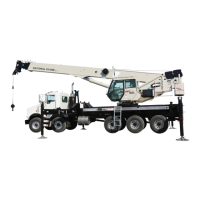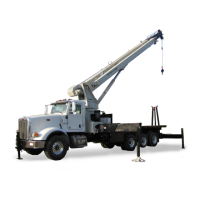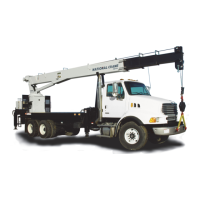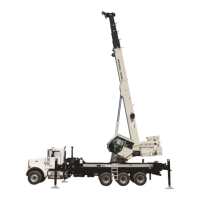National Crane 3-29-2018 Control # 610-00 5-15
NBT40-1 SERIES OPERATOR MANUAL OPERATING CONTROLS - AERIAL LIFT
Equipment Familiarization
All members of the crew should become familiar with the
location and operation of the controls, the correct operating
procedure, the maximum working range, and the Safety
Precautions in manual. Carefully follow the operating
procedures outlined below and the information in the Load
Chart/Reach Diagrams. Wear approved personnel fall
protection equipment and attach lanyard to the anchor
provided when working at elevated heights. Falling from any
elevation can result in death or serious injury.
HOIST SYSTEM OPERATION
Hoist operation is not permitted in Aerial Lift Mode.
Refer to See “Hoist System Operation” on page 4-20..
WORK SITE LOCATION
Select a location that is firm, level, and dry. Avoid uneven,
rocky or muddy terrain, steep grade or locations with
overhead obstructions. The outrigger stabilizers must be
supported on a firm level surface at the fully extended
positions. Avoid overhead power lines.
Before Leaving the Chassis Cab
• Position the equipment so that the outriggers can be
extended with no obstructions.
• Position the chassis transmission to neutral.
• Set the chassis park brake. Wheel chocks may also be
required.
• Engage the power takeoff.
• Turn the chassis cab ignition switch to OFF.
Before Performing the Aerial Lift
• Set the outriggers as described in the Equipment Level
Indicators, page 5-2 section in this manual.
• Program the RCL as specified in the Operator Manual
which is located in the crane cab.
• Check all controls for proper operation. If any abnormal
operations are detected, the condition must be corrected
before continuing.
• Check the work area for electric power lines.
Pre-use Inspection
Prior to placing the equipment in operation each day at start
of work shift, do a complete walk-around visual inspection
and look for structural damage, loose components, leaks, or
other conditions that requires immediate correction for safe
operation. The following checklist of items are suggested to
ensure the aerial lift is prepared for performing work
operations. Check the following:
• unusual conditions such as pools of hydraulic fluid or
lubricating oil under the chassis.
• outrigger which may have crept down or up.
• any signs of damage or improper maintenance.
• tires are inflated to the proper pressure.
• level of the hydraulic reservoir.
• operation of the “stop” and horn circuits.
• missing and loose bolts.
• damaged structural members and welds.
• no visible damage such as dents or cracks.
• hydraulic hoses and fittings are in good condition and
show no signs of leaking. The hoses should be free from
cuts and abrasions and there should be no evidence of
binding. Any damage or leakage should be repaired
immediately.
• electrical wiring connecting the various parts of the
system for physical damage.
• battery condition.
Aerial Lift Platform Controls
• remote control attached to platform railing mount.
• proper function of platform controls.
• switches/levers return to neutral and properly secured.
• no loose or missing parts.
• no visible damage such as dents or cracks.
• decals, placards and control markings are secure and
legible.
• RCL system for proper operation.
DANGER
Tipping Hazard!
Serious injury or death could result from improper set-up
on outriggers. Ensure outriggers are properly set and
equipment is level per operator manual.
DANGER
Chassis must be in neutral when starting engine from
ground control to avoid sudden potential movement of
chassis.

